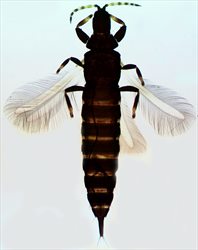
Female
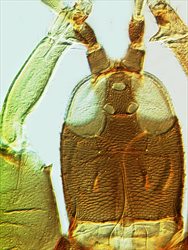
Head & fore leg
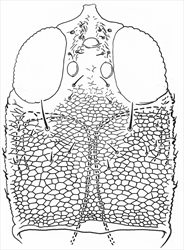
Head

Antenna

Antenna

Antennal segments III-IV
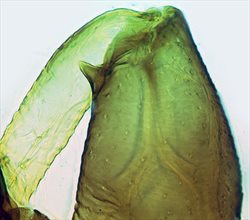
Fore femur

Female fore leg
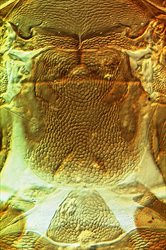
Metanotum and pelta
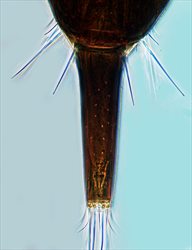
Tergites IX–X (tube)
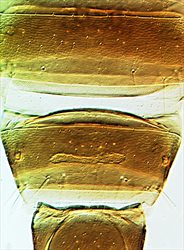
Male sternite VIII

Pelta
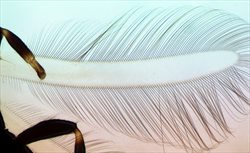
Forewing
Both sexes fully winged. Body dark brown, abdominal tergites III–VIII anterolaterally with chalky-white areas; antennae with segments III–V yellow at base; tarsi, also base and apex of mid and hind tibiae yellow; fore wing pale, sometimes with dark line medially on basal half. Antennae 8-segmented; segments III–VI constricted to apical neck; III–IV each with 3 stout sense cones. Head longer than wide; cheeks with prominent bristle-bearing warts; eyes large; maxillary stylets long and close together medially; postocular setae capitate but small, posterior to inner margin of eyes; mouth cone extending across prosternum. Pronotum reticulate, 5 pairs of capitate major setae present; basantra absent. Fore tarsus with prominent tooth; fore femora with sub-apical tubercle on inner margin. Fore wings parallel sided. Pelta reticulate; tergite IX setae blunt at apex.
Male sternite VIII with median transverse pore plate.
The genus Acanthothrips includes 13 species, of which nodicornis is Holarctic and albovittatus is from northern Europe. Of the other species, five are known only from North America, and six are from the Neotropics including Mexico. Priesner (1964) distinguished Acanthothrips from the worldwide genus Hoplandrothrips because the fore wings are parallel-sided rather than weakly constricted medially. However, although in nodicornis the fore wings are parallel-sided, in albivittatus and some of the American species the fore wings are constricted medially at least as much as in some species of Hoplandrothrips. The presence of an apical neck on antennal segments III and IV distinguishes species of Acanthothrips from those of the presumably closely related genus Phlaeothrips (Mound & Marullo, 1996), but the current generic classification of these fungus-feeding thrips possibly fails to reflect phylogenetic relationships. The European species, albovittatus, is distinguished from nodicornis by having uniformly dark antennae.
Breeding on dead branches of various tree species, and feeding on the hyphae of unidentified fungi.
In Britain, this species has been taken infrequently but widely between Surrey and Inverness (Mound et al., 1976), but it is widespread across the Holarctic (Mirab-balou et al., 2011).
PHLAEOTHRIPIDAE - PHLAEOTHRIPINAE
Acanthothrips nodicornis (Reuter)
Phloeothrips nodicornis Reuter, 1880: 16
Acanthothrips doaneii Moulton, 1907: 64
Machatothrips isshikii Ishida, 1932: 7
Acanthothrips americanus Bagnall, 1933: 123
Mirab-balou M, Tong X, Feng J & Chen X (2011) Thrips (Thysanoptera) of China. Check List 7: 720–744.
Mound LA & Marullo R (1996) The thrips of Central and South America: an introduction (Insecta: Thysanoptera). Memoirs on Entomology, International 6: 1–487.
Mound LA, Morison GD, Pitkin BR & Palmer JM (1976) Thysanoptera. Handbooks for the Identification of British Insects 1 (11): 1–79.
Priesner H (1964) Ordnung Thysanoptera. Bestimmungsbücher zur Bodenfauna Europas 2: 1–242.